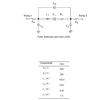saviobezerra
New Member
First, sorry for the bad english.
It's not the first time I've been looking for help on this circuit on the forum.
I'm from Brazil, I'm doing a university project using which basically consists of using a colpitts oscillator with differential pair, with a SAW sensor in its feedback loop. The SAW sensor has a frequency of 117MHz, and minimal insertion losses of ~-31dB. The challenge lies in designing the oscillator so that the gain compensates for the sensor losses. The SAW sensor model for Spice was used from another work (a master's thesis).
I managed to get my Colpitts Oscillator with differential pair oscillating at ~117MHz, but when I add the SAW the oscillation stops.
I'm not able to identify where exactly is the error of my circuit. Whether it's in the SAW model or my oscillator.
I would like any kind of help, be it articles or basic observations about my circuit.
Attached, I will put the images of the models used along with my SPICE file.
Thanks.
It's not the first time I've been looking for help on this circuit on the forum.
I'm from Brazil, I'm doing a university project using which basically consists of using a colpitts oscillator with differential pair, with a SAW sensor in its feedback loop. The SAW sensor has a frequency of 117MHz, and minimal insertion losses of ~-31dB. The challenge lies in designing the oscillator so that the gain compensates for the sensor losses. The SAW sensor model for Spice was used from another work (a master's thesis).
I managed to get my Colpitts Oscillator with differential pair oscillating at ~117MHz, but when I add the SAW the oscillation stops.
I'm not able to identify where exactly is the error of my circuit. Whether it's in the SAW model or my oscillator.
I would like any kind of help, be it articles or basic observations about my circuit.
Attached, I will put the images of the models used along with my SPICE file.
Thanks.





